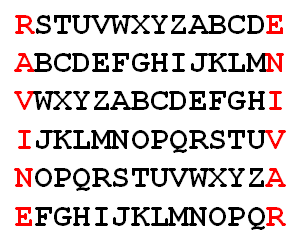Write the word RAVINE and advance each letter 13 places through the alphabet, and you’ll get RAVINE spelled backward:

Write the word RAVINE and advance each letter 13 places through the alphabet, and you’ll get RAVINE spelled backward:

In 1986 The Mathematical Intelligencer published this story about devising a mnemonic for a famous constant:
For a time I stood pondering on circle sizes. The large computer mainframe quietly processed all of its assembly code. Inside my entire hope lay for figuring out an elusive expansion. Value: pi. Decimals expected soon. I nervously entered a format procedure. The mainframe processed the request. Error. I, again entering it, carefully retyped. This iteration gave zero error printouts in all–success. Intently I waited. Soon, roused by thoughts within me, appeared narrative mnemonics relating digits to verbiage! The idea appeared to exist but only in abbreviated fashion–little phrases typically. Pressing on I then resolved, deciding firmly about a sum of decimals to use–likely around four hundred, presuming the computer code soon halted! Pondering these ideas, words appealed to me. But a problem of zeros did exist. Pondering more, solution subsequently appeared. Zero suggests a punctuation element. Very novel! My thoughts were culminated. No periods, I concluded. All residual marks of punctuation = zeros. First digit expansion answer then came before me. On examining some problems unhappily arose. That imbecilic bug! The printout I possessed showed four nine as foremost decimals. Manifestly troubling. Totally every number looked wrong. Repairing the bug took much effort. A pi mnemonic with letters truly seemed good. Counting of all the letters probably should suffice. Reaching for a record would be helpful. Consequently, I continued, expecting a good final answer from computer. First number slowly displayed on the flat screen–3. Good. Trailing digits apparently were right also. Now my memory scheme must probably be implementable. The technique was chosen, elegant in scheme: by self reference a tale mnemonically helpful was ensured. An able title suddenly existed–“Circle Digits”. Taking pen I began. Words emanated uneasily. I desired more synonyms. Speedily I found my (alongside me) Thesaurus. Rogets is probably an essential in doing this, instantly I decided. I wrote and erased more. The Rogets clearly assisted immensely. My story proceeded (how lovely!) faultlessly. The end, above all, would soon joyfully overtake. So, this memory helper story is incontestably complete. Soon I will locate publisher. There a narrative will I trust immediately appear, producing fame. THE END.
The text explains itself: Count the letters in each word (a punctuation mark other than a period counts as a 0, and a digit stands for itself), and you’ll get the first 402 digits of π.
Composed in 390 B.C., Aristophanes’ play Ecclesiazusae concludes with the name of a dish on which the characters plan to feast.
The word is lopadotemachoselachogaleokranioleipsanodrimupotrimmatosilphioliparomelitoaktakexhumeno-kichlepikossuphophattoperisteralektruonoptopiphallidokinklopeleioplagoosiraiobaphetragalopterugon. At 169 letters, it’s still the longest word in the Greek language.
In February 1852, the New York Tribune published an account by a Charles Seabury, master of the whaleship Monongahela, of a titanic struggle with a sea serpent in the South Pacific. The crew harpooned the 103-foot monster on Jan. 13 and killed it with lances the following morning:
None of the crew who witnessed that terrible scene will ever forget it; the evolutions of the body were rapid as lightning, seeming like the revolving of a thousand enormous black wheels. The tail and head would occasionally appear in the surging bloody foam, and a sound was heard, so dead, unearthly, and expressive of acute agony, that a thrill of horror ran through our veins.
The serpent was too large to get into port, so the crew resolved to save the skin, head, and bones. As they were dissecting the creature they encountered the brig Gipsy, to whom Seabury gave his story. “As soon as I get in I shall be enabled to furnish you a more detailed account.”
That’s the story. But neither Seabury, his serpent, nor his detailed account ever appeared, and the Gipsy later told the Philadelphia Bulletin that it had never met such a ship. By that time the original 2700-word account had run in Galignani’s Messenger, the Illustrated London News, the London Times, and Spenerishe Zeitung.
Zoologist editor Edward Newman concludes, “Very like a hoax, but well drawn up.” You can decide for yourself — the original account is here.

American chess grandmaster Harry Nelson Pillsbury was renowned for his memory — he could play whist, chess, and checkers simultaneously, without sight of the boards. In 1896, researchers gave him the following list of words to memorize:
antiphlogistine, periosteum, takadiastase, plasmon, ambrosia, Threlkeld, streptococcus, staphylococcus, micrococcus, plasmodium, Mississippi, Freiheit, Philadelphia, Cincinnati, athletics, no war, Etchenberg, American, Russian, philosophy, Piet Potgelter’s Rost, Salamagundi, Oomisillecootsi, Bangmanvate, Schlechter’s Nek, Manzinyama, theosophy, catechism, Madjesoomalops
Pillsbury looked over the list for a few minutes, returned it, and repeated the words correctly in order.
Then he recited them backward.
More self-contradicting words:
Zing is appeal, but zinging is criticism.
In June 1994, shortly after Pink Floyd released the album The Division Bell, someone calling himself Publius posted two messages to the newsgroup alt.music.pink-floyd:
When readers asked for proof of his authenticity, Publius wrote, “Monday, July 18, East Rutherford, New Jersey. Approximately 10:30pm. Flashing white lights. There is an enigma.” Sure enough, at the appointed time during a Floyd concert the words ENIGMA PUBLIUS appeared in white lights at the front of the stage.
Unfortunately, the clues then dwindled, no explanation was given, and no winner was ever announced. Rumors about the enigma have appeared ever since in fan circles and semi-cryptically from the band’s organization, but no one really knows what the enigma is. “It is important to note that neither I nor anyone involved with this zine will enter into any correspondence on this topic,” wrote Jeff Jensen, editor of the band’s fan magazine, in issue 34. “It’s a puzzle for you, devised by the one who loves you enough to drive you mad.”
The word EXTENSION can be rearranged into the words ONE, TEN, and SIX.
String together the numbers 1, 10, and 6 and you get 1106.
Add them and you get 17.
The word EXTENSIVELY can be rearranged into the words SIXTY and ELEVEN.
String together the numbers 60 and 11 and you get 6011.
Add them and you get 71.
Doug Nufer’s 2004 novel Never Again is aptly named — in 202 pages he never uses the same word twice. Here’s the first sentence:
When the racetrack closed forever I had to get a job.
And here’s the last (and the moral):
Worldly bookmaker soulmates rectify unfair circumstance’s recurred tragedies, ever-moving, ever-hedging shifty playabilities since chances say someone will be for ever closing racetracks.
It’s an example of an Oulipo exercise in constrained writing — here’s another.
Written in script, the word chump reads largely the same upside down.
